英语四级答题卡
- 格式:doc
- 大小:1.04 MB
- 文档页数:4
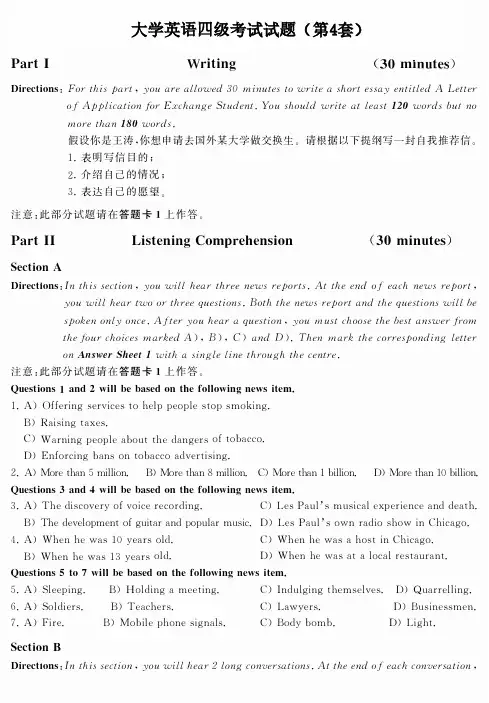
Part I ritingDirections: For th· is part, you are allowed 30 minutes to write a short essay entitled A Letter of Application for Exchange Student. You should write at least 120 words but nomore than 180 words.假设你是王涛,你想申请去国外某大学做交换生。
请根据以下提纲写一封自我推荐信。
1.表明写信目的;2.介绍自己的情况;3.表达自己的愿望。
注意:此部分试题请在答题卡1上作答。
Part II Listening Comprehension (30 minutes) Section A.Directions: In th· zs section, you will hear three news reports. At the end of each news report, you will hear two or three questions. Both the news report and the questions will bespoken only once. Af ter you hear a question, you must choose the best answer fromthe four choices marked A), B), C) and D). Then mark the corresponding letteron Answer Sheet 1 with a single line through the centre.注意:此部分试题请在答题卡1上作答。
Questions 1 and 2 will be based on the foil o wing news item.1.A) Offer ing services to help people stop smoking.B)Raising taxes.C)Warning people about the danger s of tobacco.D)Enfo rcing bans on tobacco adver tising.2.A) More than 5 million.B)More than 8 million. C) More than 1 billion.Questions 3 and 4 will be based on the foil o wing news item.D)More than 10 billion.3.A) The discover y of vo ice reco rding.B)The d evelopment of g uitar and popular music.4.A) When he was 10 year s old.C)Les Paul's musical exper ience and death.D)Les Paul's own r adio show in Chicago.C)When he was a host in Chicago.B)When he was 13 year s old.D)When he was at a local restaur ant. Questions 5 to 7 will be based on the following news item.5.A) Slee ping.B)Ho lding a meeting.C)Indulging themselves. D) Quar relling.6.A) So ldier s.B)Teacher s.C)Lawyer s.D)B usinessmen.7.A) Fire.B)M obile phone signals.C)Body bo mb.D)Light. Section BDirections: In th· is section, you will hear 2 long conversations. At th d fe en o each conversation,大学英语四级考试试题(第4套)55.According to Dr. Catriona Morrison, the public speculation.A)lacks scientific evidenceB)helps clarify their studyC)turns out to be correctD)is worth further studyPart IV Translationo· 1rect1ons: For this part, y ll d 30·ou are a owe minutes to trans ate a passage from Chinese into English. You should write your answer on Answer Sheet 2.无手机焦虑症(nomophobia) , 即因没有手机而产生的恐惧与焦虑,其具体表现有手机不能关机,去任何地方都要带着手机。
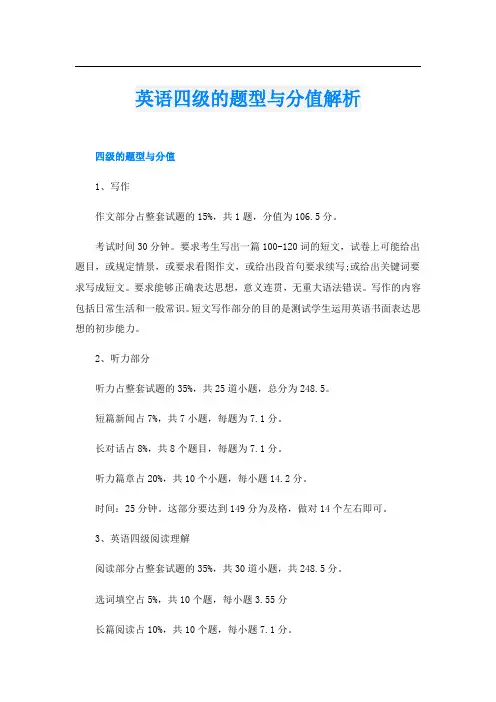
英语四级的题型与分值解析四级的题型与分值1、写作作文部分占整套试题的15%,共1题,分值为106.5分。
考试时间30分钟。
要求考生写出一篇100-120词的短文,试卷上可能给出题目,或规定情景,或要求看图作文,或给出段首句要求续写;或给出关键词要求写成短文。
要求能够正确表达思想,意义连贯,无重大语法错误。
写作的内容包括日常生活和一般常识。
短文写作部分的目的是测试学生运用英语书面表达思想的初步能力。
2、听力部分听力占整套试题的35%,共25道小题,总分为248.5。
短篇新闻占7%,共7小题,每题为7.1分。
长对话占8%,共8个题目,每题为7.1分。
听力篇章占20%,共10个小题,每小题14.2分。
时间:25分钟。
这部分要达到149分为及格,做对14个左右即可。
3、英语四级阅读理解阅读部分占整套试题的35%,共30道小题,共248.5分。
选词填空占5%,共10个题,每小题3.55分长篇阅读占10%,共10个题,每小题7.1分。
仔细阅读占20%,共10个题,共2篇,一篇5个题,每小题14.2分。
时间:40分钟。
这部分要达到149分为及格,做对18个左右即可。
4、翻译翻译部分占整套试题的15%,共1题,分值为106.5分考试时间30分钟。
段落汉译英,翻译内容涉及中国的历史、文化、经济、社会发展等。
长度为140~160个汉字。
英语四级如何备考1、优先背重点单词。
可将单词分为高频词、中频词、低频词和偶考词几个类型。
有重点的背单词。
2、刷真题。
刷真题可以帮助你找到弱点,也可以让你知道考试的重点,题型等信息。
3、逐个攻破。
一共有听力、阅读、翻译、写作这四个部分。
哪个部分最差,就花费最长的时间学习。
比较优秀的部分,每天只需要练一遍就好。
英语四级总分710分一、英语四级作文说明:写作部分占整套试卷的15%=106.5分这部分要达到63.9分为及格。
时间:30分钟二、英语四级听力部分=248.5分听力部分占整套试题的35%,除听力篇章外每个题都是7.1分。
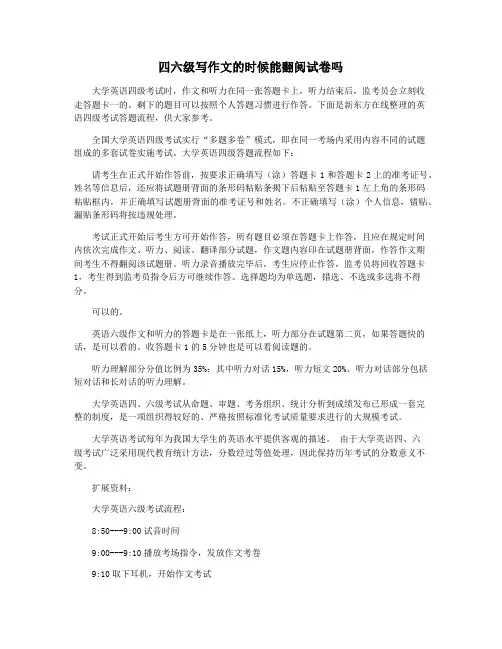
四六级写作文的时候能翻阅试卷吗大学英语四级考试时,作文和听力在同一张答题卡上,听力结束后,监考员会立刻收走答题卡一的。
剩下的题目可以按照个人答题习惯进行作答。
下面是新东方在线整理的英语四级考试答题流程,供大家参考。
全国大学英语四级考试实行“多题多卷”模式,即在同一考场内采用内容不同的试题组成的多套试卷实施考试。
大学英语四级答题流程如下:请考生在正式开始作答前,按要求正确填写(涂)答题卡1和答题卡2上的准考证号、姓名等信息后,还应将试题册背面的条形码粘贴条揭下后粘贴至答题卡1左上角的条形码粘贴框内,并正确填写试题册背面的准考证号和姓名。
不正确填写(涂)个人信息,错贴、漏贴条形码将按违规处理。
考试正式开始后考生方可开始作答,所有题目必须在答题卡上作答,且应在规定时间内依次完成作文、听力、阅读、翻译部分试题,作文题内容印在试题册背面,作答作文期间考生不得翻阅该试题册。
听力录音播放完毕后,考生应停止作答,监考员将回收答题卡1,考生得到监考员指令后方可继续作答。
选择题均为单选题,错选、不选或多选将不得分。
可以的。
英语六级作文和听力的答题卡是在一张纸上,听力部分在试题第二页,如果答题快的话,是可以看的。
收答题卡1的5分钟也是可以看阅读题的。
听力理解部分分值比例为35%;其中听力对话15%,听力短文20%。
听力对话部分包括短对话和长对话的听力理解。
大学英语四、六级考试从命题、审题、考务组织、统计分析到成绩发布已形成一套完整的制度,是一项组织得较好的、严格按照标准化考试质量要求进行的大规模考试。
大学英语考试每年为我国大学生的英语水平提供客观的描述。
由于大学英语四、六级考试广泛采用现代教育统计方法,分数经过等值处理,因此保持历年考试的分数意义不变。
扩展资料:大学英语六级考试流程:8:50---9:00试音时间9:00---9:10播放考场指令,发放作文考卷9:10取下耳机,开始作文考试9:35---9:40重新戴上耳机,试音寻台,准备听力考试9:40开始听力考试,电台开始放音9:40---10:05听力考试10:05---10:10听力考试结束后(停止答题)收答题卡一(即作文和听力)10:10---11:25继续考试,完成剩余考试11:25全部考试结束。
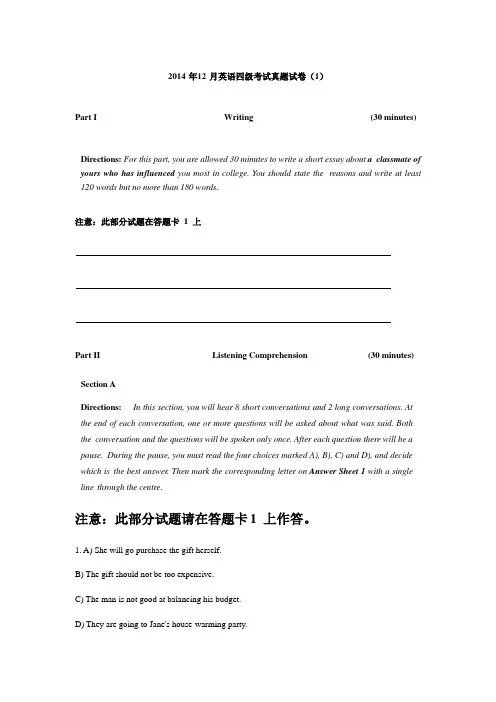
2014 年12 月英语四级考试真题试卷(1)Part I Writing (30 minutes)Directions: For this part, you are allowed 30 minutes to write a short essay about a classmate of yours who has influenced you most in college. You should state the reasons and write at least 120 words but no more than 180 words.注意:此部分试题在答题卡1 上Part II Listening Comprehension (30 minutes) Section ADirections: In this section, you will hear 8 short conversations and 2 long conversations. At the end of each conversation, one or more questions will be asked about what was said. Both the conversation and the questions will be spoken only once. After each question there will be a pause. During the pause, you must read the four choices marked A), B), C) and D), and decide which is the best answer. Then mark the corresponding letter on Answer Sheet 1 with a single line through the centre.注意:此部分试题请在答题卡 1 上作答。
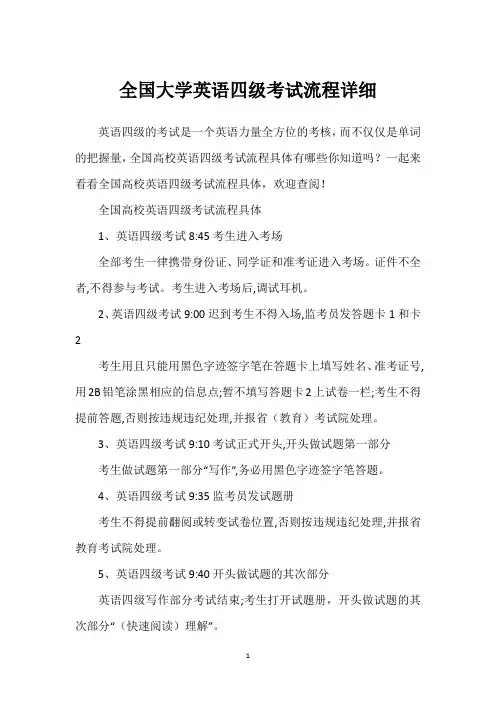
全国大学英语四级考试流程详细英语四级的考试是一个英语力量全方位的考核,而不仅仅是单词的把握量,全国高校英语四级考试流程具体有哪些你知道吗?一起来看看全国高校英语四级考试流程具体,欢迎查阅!全国高校英语四级考试流程具体1、英语四级考试8:45考生进入考场全部考生一律携带身份证、同学证和准考证进入考场。
证件不全者,不得参与考试。
考生进入考场后,调试耳机。
2、英语四级考试9:00迟到考生不得入场,监考员发答题卡1和卡2考生用且只能用黑色字迹签字笔在答题卡上填写姓名、准考证号,用2B铅笔涂黑相应的信息点;暂不填写答题卡2上试卷一栏;考生不得提前答题,否则按违规违纪处理,并报省(教育)考试院处理。
3、英语四级考试9:10考试正式开头,开头做试题第一部分考生做试题第一部分“写作”,务必用黑色字迹签字笔答题。
4、英语四级考试9:35监考员发试题册考生不得提前翻阅或转变试卷位置,否则按违规违纪处理,并报省教育考试院处理。
5、英语四级考试9:40开头做试题的其次部分英语四级写作部分考试结束;考生打开试题册,开头做试题的其次部分“(快速阅读)理解”。
6、英语四级考试9:55收答题卡1收卷期间考生不得答题,否则按违规违纪处理,并报省教育考试院处理。
7、英语四级考试10:00听力考试正式开头。
8、英语四级听力考试结束后,开头做试题的第四部分英语四级听力考试结束后,请马上摘下耳机,否则按违规违纪处理,并报省教育考试院处理;考生开头做试题的第四部分。
9、英语四级11:20考试结束英语四级考试结束,考生马上停止答题,不离开座位,待监考老师收齐试卷、清点考试材料无误并同意考生离场后,考生方可退场。
10、考生不得提前退场和交卷英语四级考试过程中,考生不得提前退场,包括提前交卷,否则按违规违纪处理,并报省教育考试院处理。
11、考生进入考场需携带2B铅笔和黑色签字笔,不得携带(其它)材料考生进入考场不得携带的材料如书本、纸张、书包、录音器材、电子记事本和通讯工具(含BP机、对讲机和手机等均不得带入考场,否则按违规违纪处理,并报省教育考试院处理。
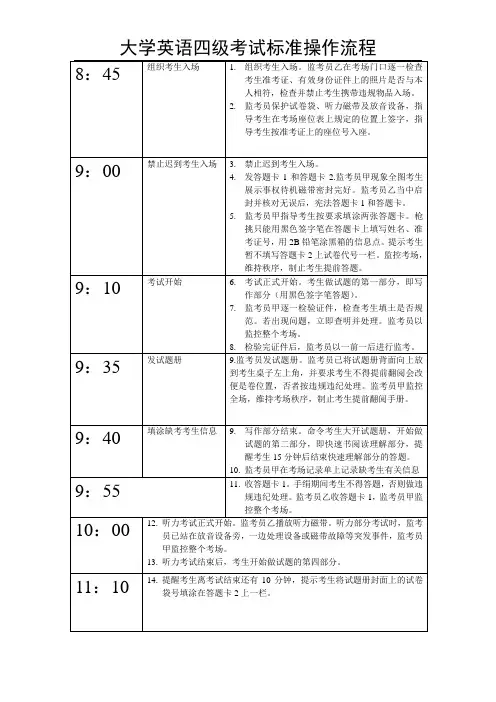
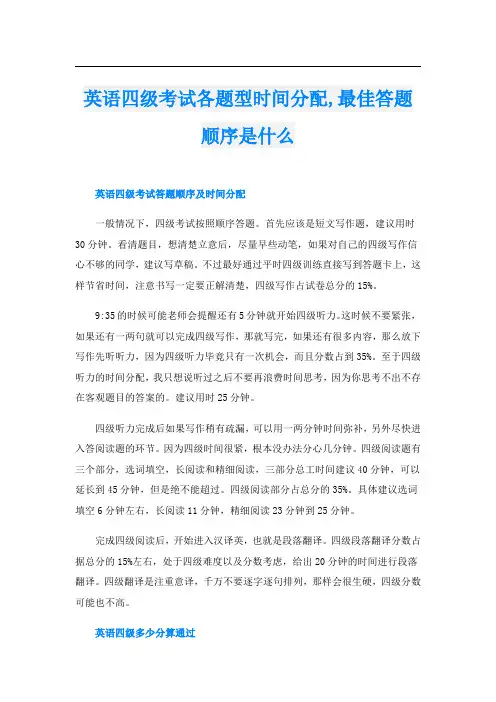
英语四级考试各题型时间分配,最佳答题顺序是什么英语四级考试答题顺序及时间分配一般情况下,四级考试按照顺序答题。
首先应该是短文写作题,建议用时30分钟。
看清题目,想清楚立意后,尽量早些动笔,如果对自己的四级写作信心不够的同学,建议写草稿。
不过最好通过平时四级训练直接写到答题卡上,这样节省时间,注意书写一定要正解清楚,四级写作占试卷总分的15%。
9:35的时候可能老师会提醒还有5分钟就开始四级听力。
这时候不要紧张,如果还有一两句就可以完成四级写作,那就写完,如果还有很多内容,那么放下写作先听听力,因为四级听力毕竟只有一次机会,而且分数占到35%。
至于四级听力的时间分配,我只想说听过之后不要再浪费时间思考,因为你思考不出不存在客观题目的答案的。
建议用时25分钟。
四级听力完成后如果写作稍有疏漏,可以用一两分钟时间弥补,另外尽快进入答阅读题的环节。
因为四级时间很紧,根本没办法分心几分钟。
四级阅读题有三个部分,选词填空,长阅读和精细阅读,三部分总工时间建议40分钟,可以延长到45分钟,但是绝不能超过。
四级阅读部分占总分的35%。
具体建议选词填空6分钟左右,长阅读11分钟,精细阅读23分钟到25分钟。
完成四级阅读后,开始进入汉译英,也就是段落翻译。
四级段落翻译分数占据总分的15%左右,处于四级难度以及分数考虑,给出20分钟的时间进行段落翻译。
四级翻译是注重意译,千万不要逐字逐句排列,那样会很生硬,四级分数可能也不高。
英语四级多少分算通过英语四级425分算过。
大学英语四级改革之后,满分为710分,凡考试成绩在220分以上的考生,由国家教育部高教司委托"全国大学英语四六级考试委员会”颁发成绩单,不设及格线。
因大学英语四级曾规定"英语四级成绩达到425分以上(含425分)者,可以报考英语六级”,所以,一般默认大学英语四级的合格线为425分。
一般来说考试正确率达到60%就算合格,比如英语四六级的总分都是710分,按照正确率达到60%才算合格的话,英语四六级的合格分数应为426分,但通常考到425分(含425分)以上就算是合格了。
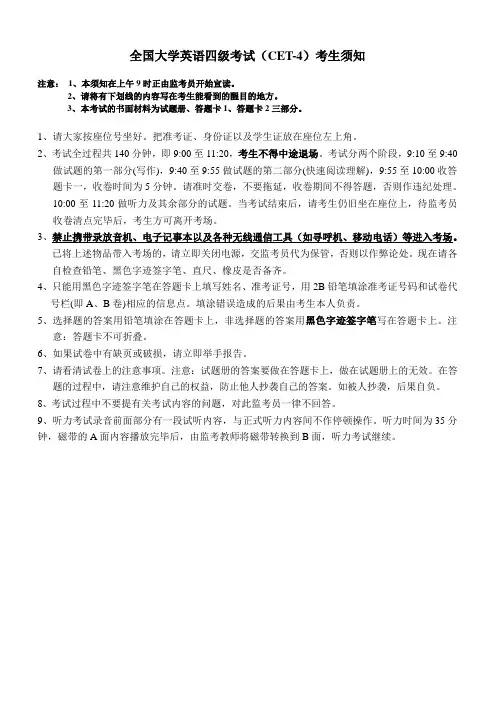
全国大学英语四级考试(CET-4)考生须知注意:1、本须知在上午9时正由监考员开始宣读。
2、请将有下划线的内容写在考生能看到的醒目的地方。
3、本考试的书面材料为试题册、答题卡1、答题卡2三部分。
1、请大家按座位号坐好。
把准考证、身份证以及学生证放在座位左上角。
2、考试全过程共140分钟,即9:00至11:20,考生不得中途退场。
考试分两个阶段,9:10至9:40做试题的第一部分(写作),9:40至9:55做试题的第二部分(快速阅读理解),9:55至10:00收答题卡一,收卷时间为5分钟。
请准时交卷,不要拖延,收卷期间不得答题,否则作违纪处理。
10:00至11:20做听力及其余部分的试题。
当考试结束后,请考生仍旧坐在座位上,待监考员收卷清点完毕后,考生方可离开考场。
3、禁止携带录放音机、电子记事本以及各种无线通信工具(如寻呼机、移动电话)等进入考场。
已将上述物品带入考场的,请立即关闭电源,交监考员代为保管,否则以作弊论处。
现在请各自检查铅笔、黑色字迹签字笔、直尺、橡皮是否备齐。
4、只能用黑色字迹签字笔在答题卡上填写姓名、准考证号,用2B铅笔填涂准考证号码和试卷代号栏(即A、B卷)相应的信息点。
填涂错误造成的后果由考生本人负责。
5、选择题的答案用铅笔填涂在答题卡上,非选择题的答案用黑色字迹签字笔写在答题卡上。
注意:答题卡不可折叠。
6、如果试卷中有缺页或破损,请立即举手报告。
7、请看清试卷上的注意事项。
注意:试题册的答案要做在答题卡上,做在试题册上的无效。
在答题的过程中,请注意维护自己的权益,防止他人抄袭自己的答案。
如被人抄袭,后果自负。
8、考试过程中不要提有关考试内容的问题,对此监考员一律不回答。
9、听力考试录音前面部分有一段试听内容,与正式听力内容间不作停顿操作。
听力时间为35分钟,磁带的A面内容播放完毕后,由监考教师将磁带转换到B面,听力考试继续。
全国大学英语六级考试(CET-6)考生须知注意:1、本须知在下午3时正由监考员开始宣读。
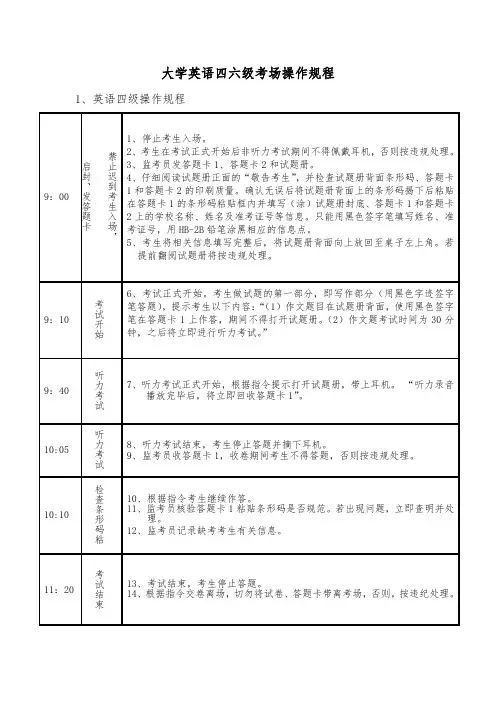
大学英语四六级考场操作规程1、英语四级操作规程9:00禁止迟到考生入场,启封、发答题卡1、停止考生入场。
2、考生在考试正式开始后非听力考试期间不得佩戴耳机,否则按违规处理。
3、监考员发答题卡1、答题卡2和试题册。
4、仔细阅读试题册正面的“敬告考生”,并检查试题册背面条形码、答题卡1和答题卡2的印刷质量。
确认无误后将试题册背面上的条形码揭下后粘贴在答题卡1的条形码粘贴框内并填写(涂)试题册封底、答题卡1和答题卡2上的学校名称、姓名及准考证号等信息。
只能用黑色签字笔填写姓名、准考证号,用HB-2B铅笔涂黑相应的信息点。
5、考生将相关信息填写完整后,将试题册背面向上放回至桌子左上角。
若提前翻阅试题册将按违规处理。
9:10 考试开始6、考试正式开始。
考生做试题的第一部分,即写作部分(用黑色字迹签字笔答题),提示考生以下内容:“(1)作文题目在试题册背面,使用黑色签字笔在答题卡1上作答,期间不得打开试题册。
(2)作文题考试时间为30分钟,之后将立即进行听力考试。
”9:40 听力考试7、听力考试正式开始,根据指令提示打开试题册,带上耳机。
“听力录音播放完毕后,将立即回收答题卡1”。
10:05收答题卡听力考试结束8、听力考试结束,考生停止答题并摘下耳机。
9、监考员收答题卡1,收卷期间考生不得答题,否则按违规处理。
10:10记录缺考情况检查条形码粘贴情况10、根据指令考生继续作答。
11、监考员核验答题卡1粘贴条形码是否规范。
若出现问题,立即查明并处理。
12、监考员记录缺考考生有关信息。
11:20 考试结束13、考试结束,考生停止答题。
14、根据指令交卷离场,切勿将试卷、答题卡带离考场,否则,按违纪处理。
2、英语六级操作规程15:00禁止迟到考生入场,启封、发答题卡1、停止迟到考生入场。
2、考生在考试正式开始后非听力考试期间不得佩戴耳机,否则按违规处理。
3、发答题卡1、答题卡2和试题册。
4、考生检查试题册背面条形码、答题卡1和答题卡2的印刷质量,确认无误后将试题册背面上的条形码揭下后粘贴在答题卡1的条形码粘贴框内并填写(涂)试题册封底、答题卡1和答题卡2上的学校名称、姓名及准考证号等信息。
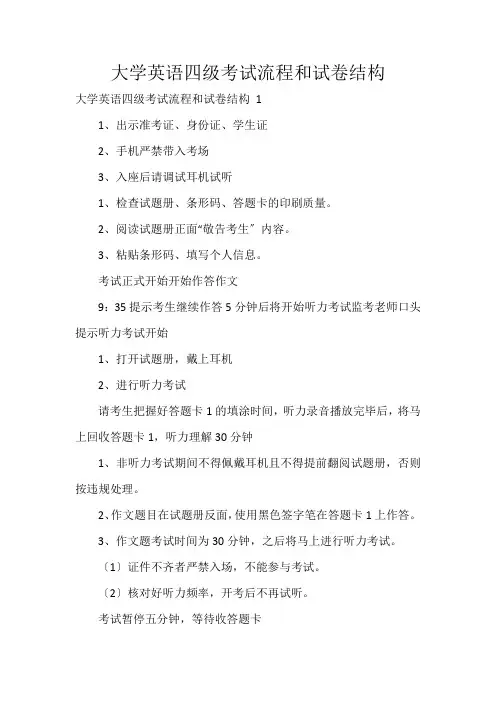
大学英语四级考试流程和试卷结构大学英语四级考试流程和试卷结构11、出示准考证、身份证、学生证2、手机严禁带入考场3、入座后请调试耳机试听1、检查试题册、条形码、答题卡的印刷质量。
2、阅读试题册正面“敬告考生〞内容。
3、粘贴条形码、填写个人信息。
考试正式开始开始作答作文9:35提示考生继续作答5分钟后将开始听力考试监考老师口头提示听力考试开始1、打开试题册,戴上耳机2、进行听力考试请考生把握好答题卡1的填涂时间,听力录音播放完毕后,将马上回收答题卡1,听力理解30分钟1、非听力考试期间不得佩戴耳机且不得提前翻阅试题册,否则按违规处理。
2、作文题目在试题册反面,使用黑色签字笔在答题卡1上作答。
3、作文题考试时间为30分钟,之后将马上进行听力考试。
〔1〕证件不齐者严禁入场,不能参与考试。
〔2〕核对好听力频率,开考后不再试听。
考试暂停五分钟,等待收答题卡作答阅读理解和翻译部分11:10提示考生继续作答,把握好时间10分钟后考试讲结束监考老师口头提示考生停止作答1、考生交回试题册、答题卡2。
2、老师清点无误后考生方可离场。
试卷结构1、试卷构成四级和六级的试卷构成相同,由写作、听力理解、阅读理解和翻译四个部分组成,分值比例为:写作15%,听力35%,阅读35%,翻译15%。
考试时间为130分钟。
四级和六级的试卷结构、测试内容、测试题型、分值比例和考试时间如下表所示:建议先从听力的听力章和阅读的认真阅读下手因为这两项相加占总分的百分之四十,分值最高,相对难度也比较大需要提前开始备考,要保证有充分的时间做肯定量的题,还要保证对所做的题进行仔细的分析总结,进行错误分析归纳。
2、题型描述(1〕写作写作部分测试学生用英语进行书面表达的能力,所占分值比例为15%,考试时间30分钟。
写作测试选用考生所熟识的题材,要求考生依据所提供的信息及提示〔如:提纲、情景、图片或图表等〕写出一短文,四级120—180词,六级150—200词。
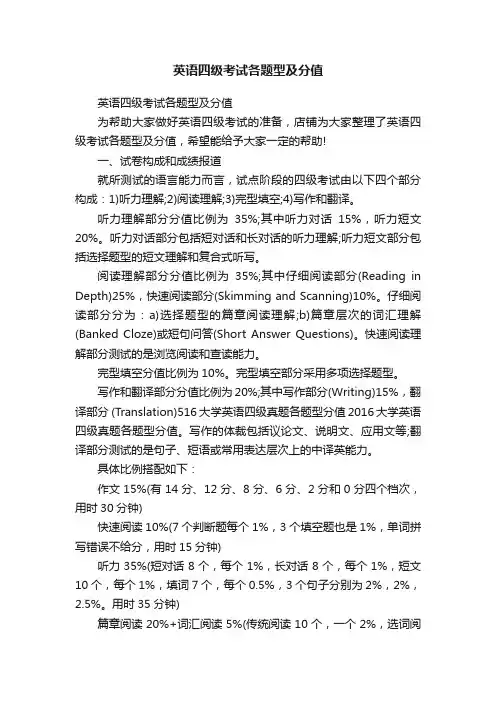
英语四级考试各题型及分值英语四级考试各题型及分值为帮助大家做好英语四级考试的准备,店铺为大家整理了英语四级考试各题型及分值,希望能给予大家一定的帮助!一、试卷构成和成绩报道就所测试的语言能力而言,试点阶段的四级考试由以下四个部分构成:1)听力理解;2)阅读理解;3)完型填空;4)写作和翻译。
听力理解部分分值比例为35%;其中听力对话15%,听力短文20%。
听力对话部分包括短对话和长对话的听力理解;听力短文部分包括选择题型的短文理解和复合式听写。
阅读理解部分分值比例为35%;其中仔细阅读部分(Reading in Depth)25%,快速阅读部分(Skimming and Scanning)10%。
仔细阅读部分分为:a)选择题型的篇章阅读理解;b)篇章层次的词汇理解(Banked Cloze)或短句问答(Short Answer Questions)。
快速阅读理解部分测试的是浏览阅读和查读能力。
完型填空分值比例为10%。
完型填空部分采用多项选择题型。
写作和翻译部分分值比例为20%;其中写作部分(Writing)15%,翻译部分 (Translation)516大学英语四级真题各题型分值2016大学英语四级真题各题型分值。
写作的体裁包括议论文、说明文、应用文等;翻译部分测试的是句子、短语或常用表达层次上的中译英能力。
具体比例搭配如下:作文15%(有14分、12分、8分、6分、2分和0分四个档次,用时30分钟)快速阅读10%(7个判断题每个1%,3个填空题也是1%,单词拼写错误不给分,用时15分钟)听力35%(短对话8个,每个1%,长对话8个,每个1%,短文10个,每个1%,填词7个,每个0.5%,3个句子分别为2%,2%,2.5%。
用时35分钟)篇章阅读20%+词汇阅读5%(传统阅读10个,一个2%,选词阅读10%,一个0.5%。
用时25分钟)完型填空10%(20个小题,一题0.5%。
用时15分钟)翻译5%(一题1%。
四级试卷排版要求(可直接在模板上修改)字体:中文宋体;英文Times New Roman行间距:1.5倍一级标题:三号、加粗,根据情况选择居中(Ctrl+E)或两端对齐(Crtl+J)Part I、Ⅱ部分在制表符中别设置左0字符中22字符右45字符对齐二级标题:四号、加粗(Ctrl+B)正文:五号、正常题目与题目之间不空行A/B/C/D选项按TAB键2、12、22、32字符对齐选词填空:先插入表格,再选无框线下划线:按英文输入法下Shift+“-”减号(填空题3下划线+题号+3下划线如:___26___; 阅读题10下划线__________)段落匹配:悬挂缩进2字符作文标题:倾斜(Ctrl+I)机密★启用前大学英语四级考试COLLEGE ENGLISH TEST-Band four-(模拟测试卷第3套)试题册☆☆☆☆☆☆☆☆☆☆☆☆☆☆☆☆☆☆☆☆☆☆☆☆☆☆☆☆☆☆☆☆☆☆☆☆☆☆☆☆敬告考生一、在答题前, 请认真完成以下内容:1. 请检查试题册背面条形码粘贴条、答题卡的印刷质量,如有问题及时向监考员反映, 确认无误后完成以下两点要求。
2. 请将试题册背面条形码粘贴条揭下后粘贴在答题卡1的条形码粘贴框内,并将姓名和准考证号填写在试题册背面相应位置。
3. 请在答题卡1和答题卡2指定位置用黑色签字笔填写准考证号、姓名和学校名称,并用HB-2B 铅笔将对应准考证号的信息点涂黑。
二、在考试过程中, 请注意以下内容:1. 所有题目必须在答题卡上规定位置作答,在试题册上或答题卡上非规定位置的作答一律无效。
2. 请在规定时间内在答题卡指定位置依次完成作文、听力、阅读、翻译各部分考试,作答作文期间不得翻阅该试题册。
听力录音播放完毕后,请立即停止作答,监考员将立即收回答题卡1,得到监考员指令后方可继续作答。
3. 作文题内容印在试题册背面, 作文题及其他主观题必须用黑色签字笔在答题卡指定区域内作答。
4. 选择题均为单选题,错选、不选或多选将不得分,作答时必须使用HB-2B铅笔在答题卡上相应位置填涂,修改时须用橡皮擦净。
2019年12月大学英语四级考试真题(第3套)COLLEGE ENGLISH TEST——Band four——试题册☆☆☆☆☆☆☆☆☆☆☆☆☆☆☆☆☆☆☆☆☆☆☆☆☆敬告考生一、在答题前,请认真完成以下内容:1.请检查试题册背面条形码粘贴条、答题卡的印刷质量,如有问题及时向监考员反映,确认无误后完成以下两点要求。
2.请将试题册背面条形码粘贴条揭下后粘贴在答题卡1的条形码粘贴框内,并将姓名和准考证号填写在试题册背面相应位置。
3.请在答题卡1和答题卡2指定位置用黑色签字笔填写准考证号、姓名和学校名称,并用HB-2B铅笔将对应准考证号的信息点涂黑。
二、在考试过程中,请注意以下内容:1.所有题目必须在答题卡上规定位置作答,在试题册上或答题卡上非规定位置的作答一律无效。
2.请在规定时间内在答题卡指定位置依次完成作文、听力、阅读、翻译各部分考试,作答作文期间不得翻阅该试题册。
听力录音播放完毕后,请立即停止作答,监考员将立即收回答题卡1,得到监考员指令后方可继续作答。
3.作文题内容印在试题册背面,作文题及其他主观题必须用黑色签字笔在答题卡指定区域内作答。
4.选择题均为单选题,错选、不选或多选将不得分,作答时必须使用HB2B铅笔在答题卡上相应位置填涂,修改时须用橡皮擦净。
三、以下情况按违规处理:1.未正确填写(涂)个人信息,错贴、不贴、毁损条形码粘贴条。
2.未按规定翻阅试题册、提前阅读试题、提前或在收答题卡期间作答。
3.未用所规定的笔作答、折叠或毁损答题卡导致无法评卷。
4.考试期间在非听力考试时间佩戴耳机。
Part I Writing (30 minutes) Directions: For this part, you are allowed 30 minutes to write a letter to a foreign friend who wants to study in China. Please recommend a university to him. You should write at least 120 words but no more than 180 words.______________________________________________________________________________________________ ___________________________________________________________________________________________________ ___________________________________________________________________________________________________ Part II Listening Comprehension (30 minutes)特别说明四级考试每次仅考两套听力第三套听力试题同第一套或第二套试题一致Part III Reading Comprehension (40 minutes) Section ADirections:In this section, there is a passage with ten blanks. You are required to select one word for each blank from a list of choices given in a word bank following the passage. Read the passage through carefully before making your choices. Each choice in the bank is identified by a letter. Please mark the corresponding letter for each item on Answer Sheet 2 with a single line through the centre. You may not use any of the words in the bank more than once.Millions of people travel by plane every single day. If you’re planning on being one of them soon, you might not be looking forward to the 26 feeling air travel often leaves you with.Besides the airport crowds and stress, travelling at a high altitude has real effects on the body. Although the pressure of the cabin is 27 to prevent altitude sickness, you could still 28 sleepiness or a headache. The lower oxygen pressure found in an aircraft cabin is 29 to that at 6,000-8,000 feet of altitude. A drop in oxygen pressure can cause headaches in certain 30 To help prevent headaches, drink plenty of water, and avoid alcohol and coffee.Airplane food might not really be as tasteless as you 31 thought. The air you breathe in a plane dries out your mouth and nose, which can affect your sense of taste. Perception of sweet and salty foods dropped by almost 30 percent in a simulation of air travel. However, you can make your taste buds active again by drinking water. A dry mouth may 32 taste sensitivity, but taste is restored by drinking fluids.Although in-flight infections 33 in dry environments like airplanes, your risk of getting sick from an airplane is actually low because of the air 34 used. Unless you’re sitting next to someone who is coughing or sneezing, you shouldn’t worry too much about getting sick. However, bacteria have been shown to live on cabin surfaces, so wash your hands 35 .Section BDirections: In this section, you are going to read a passage with ten statements attached to it. Each statement contains information given in one of the paragraphs. Identify the paragraph from which the information is derived. You may choose a paragraph more than once. Each paragraph is marked with a letter. Answer the questions by marking the corresponding letter on Answer Sheet 2.A South Korean city designed for the future takes on a life of its own[A] Getting around a city is one thing—and then there5s the matter of getting from one city to another. One vision of the perfect city of the future is a place that offers easy access to air travel. In 2011, a University of North Carolina business professor named John Kasarda published a book called Aerotropolis: The Way We’ll Live Next. Kasarda says f uture cities should be built intentionally around or near airports. The idea, as he has put it, is to offer businesses “rapid, long-distance connectivity on a massive scale.”[B] “The 18th centu ry really was a waterborne (水运的) centu ry, the 19th century a rail century,’’ century a highway, car, truck century—and the 21st century will increasingly be an aviation century, as the globe becomes increasingly connected by air,55 Kasarda says. Songdo, a city built from scratch in Sout h Korea, is one of Kasarda’s prime examples. It has existed for just a few years. “From the outset, it was designed on the basis of connectivity and competitivenesss,” says Kasarda. “The government built the bridge directly from the airport to the Songdo I nternational Business District. And the surface infrastructure was built at the same time as the new airport.”[C] Songdo is a stone’s throw from South Korea’s Incheon Airport, its main international hub (枢纽). But it takes a lot more than a nearby airport to be a city of the future. Just building a place as an "international business district” doesn’t mean it will become one. Park Yeon Soo conceived (构想) this city of the future back in 1986. He considers Songdo his baby. Park sees himself as a visionary. Thirty years after he imagined the city, Park5s baby is close to 70 percent built, with 36,000 people living in the business district and 90,000 residents in greater Songdo. It’s about an hour outside Seoul, built on former tidal flats along the Yellow Sea. There’s a Coast Guard building and a tall trade tower, as well as a park, golf course and university.[D] Chances are you’v e actually seen this place. Songdo appears in the most famous music video ever to come out of South Korea. “Gangnam Style” refers to the fashionable Gangnam district in Seoul. But some of the video was filmed in Songdo. “I don’t know if you remember, there was a scene in a subway station. That was not Gangnam. That was actually Songdo, says Jung Won Son, a professor of urban development at London’ Bartlett School of Planning. “Part of the reason to shoot there is that it’s new and nice.”[E] The city was supposed to be a hub for global companies, with employees from all over the world. But tha t’s not how it has turned out. Songdo’ reputation is as a f uturistic ghost town. But the reality is more complicated. A bridge with big, light-blue loops leads into the business distr ict. In the center of the main road, there’s a long line of flags of the world. On the comer, there’s a Starbucks and a 7-Eleven—all of the international brands that you see all over the world nowadays.[F] The city is not empty. There are mothers pushing baby carriages, old women with walkers—even in the middle of the day, when it5s 90 degrees out. Byun Young-Jin chairs the Songdo real estate association and started selling property here when the first phase of the city opened in 2005. He says demand has boomed in the past couple of years. Most of his clientsare Korean. In fact, the developer says, 99 percent of the homes here are sold to Koreans. Young families move here because the schools are great. And that’s the problem: Songdo has become a popular Korean city——more popular as a residential area than a business one. Ifs not yet the futuristic international business hub that planners imagined. “It’s a great place to live. And it’s becoming a great place to work,55 says Scott Summers, vice president of G ale International, the developer of the city. The floor-to-ceiling windows of his company’ offices overlook Songdo Central Park, with a canal full of small boats and people fishing. Shimmering (闪烁着)glass towers line the canal’s edge.[G] "What happened is that our focus on creating that quality of life first has enabled the residents to live here,” Summers says. But there needs to be strong economic incentives for companies to locate here. The city is still unfinished, and it feels a bit like a theme park. It doesn’t feel all that futuristic. There’s a high-tech underground trash disposal system. Buildings are environm entally friendly. Everybody’ television set is connected to a system that streams personalized language or exercise classes.[H] But this is not Star Trek. And to some of the residents, Songdo feels hollow. 'Tm, like, in prison for weekdays. That’s what we call it in the workplace, says a woman in her 20s. She doesn’t want to use her name for fear of being fired from her job. She goes back to Seoul every weekend. "I say I’m prison-breaking on Friday nights,” But she has to make the prison break in her own car. There5s no high-speed train connecting Songdo to Seoul, just over 20 miles away.[I] Park Yeon Soo, the man who first imagined Songdo, feels frustrated, too. He says he built South Korea a luxury vehicle, “like Mercedes or BMW. It’s a good car now. But we’re waiting for a good driver to accelerate.” But there are lots o f other good cars out there, too. The world is dotted with futuristic, high-tech cities trying to attract the biggest international companies.[J] Songdo’s backers contend that it’s still early, and business space is filling up—about 70 percent of finished offices are now occupied. Brent Ryan, who teaches urban des ign at MIT, says Songdo proves a universal principle. “There have been a lot of utopian (乌邦托的) cities in history. And the reason we don’t know about a lot of them is that they have vanished entirely. In other words, when it comes to cities—or anything else—it is hard to predict the future.36. Songdo’ popularity lies more in its quality of life than its business attraction.37. The man who conceived Songdo feels disappointed because it has fallen short of his expectations.38. A scene in a popular South Korean music video was shot in Songdo.39. Songdo still lacks the financial stimulus for businesses to set up shop there.40. Airplanes will increasingly become the chief means of transportation, according to a professor.41. Songdo has ended up different from the city it was supposed to be.42. Some of the people who work in Songdo complain about boredom in the workplace.43. A business professor says that a future city should have easy access to international transportation.44. According to an urban design professor, it is difficult for city designers to foresee what will happen in the future.45. Park Yeon Soo, who envisioned Songdo, feels a parental connection with the city.Section CDirections: There are 2 passages in this section. Each passage is followed by some questions or unfinished statements. Foreach of them there are four choices marked A), B), C) and D). You should decide on the best choice and mark the corresponding letter on Answer Sheet 2 with a single line through the centre.Passage OneQuestions 46 to 50 are based on the following passage.The fifth largest city in the US passed a significant soda tax proposal that will l evy(征税1.5cents per liquid ounce on distributors.Philadelphia’ new measure was approved by a 13 to 4 city council vote. It sets a new bar for similar initiatives across the country. It is proof that taxes on sugary drinks can win substantial support outside super-liberal areas. Until now, the only city to successfully pass and implement a soda tax was Berkeley, California, in 2014.The tax will apply to regular and diet sodas, as well as other drinks with added sugar, such as Gatorade and iced teas. Ifs expected to raise $410 million over the next five years, most of which will go toward funding a universal pre-kindergarten program for the city.While the city council vote was met with applause inside the council room, opponents to the measure, including soda lobbyists, made sharp criticisms and a promise to challenge the tax in court."The tax passed today unfairly singles out beverages —including low-and no-calorie choices,” said Lauren Kane, spokeswoman for the American Beverage Association. "But most importantly, it is against the law. So we will side with the majority of the people of Philadelphia who oppose this tax and take legal action to stop it.55Ail industry-backed anti-tax campaign has spent at least $4 million on advertisements. The ads criticized the measure, characterizing it as a “grocery tax.”Public health groups applauded the approved tax as a step toward fixing certain lasting health issues that plague Americans. 'The move to recapture a small part of the profits from an industry that pushes a product that contributes to diabetes, obesity and heart disease in poorer communities in order to reinvest in those communities will sure be inspirational to many other places,” said Jim Krieger, executive director of Healthy Food America. “Indeed, we are already hearing from some of them. It’s not ‘just Berkeley’ anymore.”Similar measures in California’ Albany, Oakland, San Francisco and Colorado’ Boulder are becoming hot- button issues. Health advocacy groups have hinted that even more might be coming.46. What does the passage say about the newly-approved soda tax in Philadelphia?A) It will change the lifestyle of many consumers.B) It may encourage other US cities to follow suit.C) It will cut soda consumption among low-income communities.D) It may influence the marketing strategies of the soda business.47. What will the opponents probably do to respond to the soda tax proposal?A) Bargain with the city council. B) Refuse to pay additional tax.C) Take legal action against it. D) Try to win public support.48. What did the industry-backed anti-tax campaign do about the soda tax proposal?A) It tried to arouse hostile feelings amongconsumers. B) It tried to win grocers’ support against the measure.C) It kept sending letters of protest to the media. D) It criticized the measure through advertising.49. What did public health groups think the soda tax would do?A) Alert people to the risk of sugar-induced diseases. B) Help people to fix certain long-time health issues.C) Add to the fond for their research on diseases. D) Benefit low-income people across the country.50. What do we learn about similar measures concerning the soda tax in some other cities?A) They are becoming rather sensitive issues.B) They are spreading panic in the soda industry.C) They are reducing the incidence of sugar-induced diseases.D) They are taking away a lot of profit from the soda industry.Passage TwoQuestions 51 to 55 are based on the following passage.Popping food into the microwave for a couple of minutes may seem utterly harmless, but Europe’stock of these quick-cooking ovens emit as much carbon as nearly 7 million cars, a new study has found. And the problem is growing. With costs falling and kitchen appliances becoming “status” items, owners are throwing away microwaves after an aver age of eight years. This is pushing sales of new microwaves which are expected to reach 135 million annually in the EU by the end of the decade.A study by the University of Manchester calculated the emissions of C02—the main greenhouse gas responsible for climate change—at every stage of microwaves, from manufacture to waste disposal. “It is electricity consumption by microwaves that has the biggest impact on the environment,” say the authors. The authors also calculate that the emissions from using 19 microwaves over a year are the same as those from using a car. According to the same study, efforts to reduce consumption should focus on improving consumer awareness and behavior. For example, consumers could use appliances in a more efficient way by adjusting the time of cooking to the type of food.However, David Reay, professor of carbon management, argues that, although microwaves use a great deal of energy, their emissions are minor compared to those from cars. In the UK alone, there are around 30 million cars. These cars emit more than all the microwaves in the EU. Backing this up, recent data show that passenger cars in the UK emitted 69 million tons of CO2 in 2015. This is 10 times the amount this new microwave oven study estimates for annual emissions for all the microwave ovens in the EU. Further, the energy used by microwaves is lower than any other form of cooking. Among common kitchen appliances used for cooking, microwaves are the most energy efficient, followed by a stove and finally a standard oven. Thus, rising microwave sales could be seen as a positive thing51. What is the finding of the new study?A) Quick-cooking microwave ovens have become more popular.B) The frequent use of microwaves may do harm to our health.C) CO2 emissions constitute a major threat to the environment.D) The use of microwaves emits more C02 than people think.52. Why are the sales of microwaves expected to rise?A) They are becoming more affordable.B) They have a shorter life cycle than other appliances.C) They are getting much easier to operate.D) They take less time to cook than other appliances.53. What recommendation does the study by the University of Manchester make?A) Cooking food of different varieties. B) Improving microwave users5 habits.C) Eating less to cut energy consumption. D) Using microwave ovens less frequently.54. What does Professor David Reay try to argue?A) There are far more emissions from cars than from microwaves.B) People should be persuaded into using passenger cars less often.C) The UK produces less C〇2 than many other countries in the EU.D) More data are needed to show whether microwaves are harmful.55. What does Professor David Reay think of the use of microwaves?A) It will become less popular in the coming decades.B) It makes everyday cooking much more convenient.C) It plays a positive role in environmental protection.D) It consumes more power than conventional cooking.Part ⅣTranslation (30 minutes) Directions: For this part, you are allowed 30 minutes to translate a passage from Chinese into English. You should write your answer on Answer Sheet 2.中国汉族人的全名由姓和名组成。